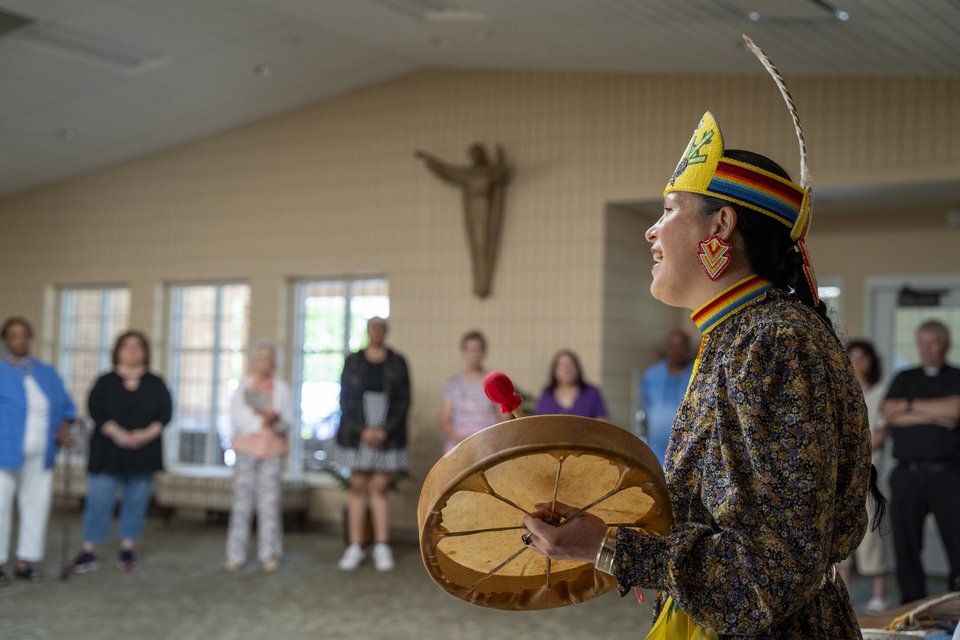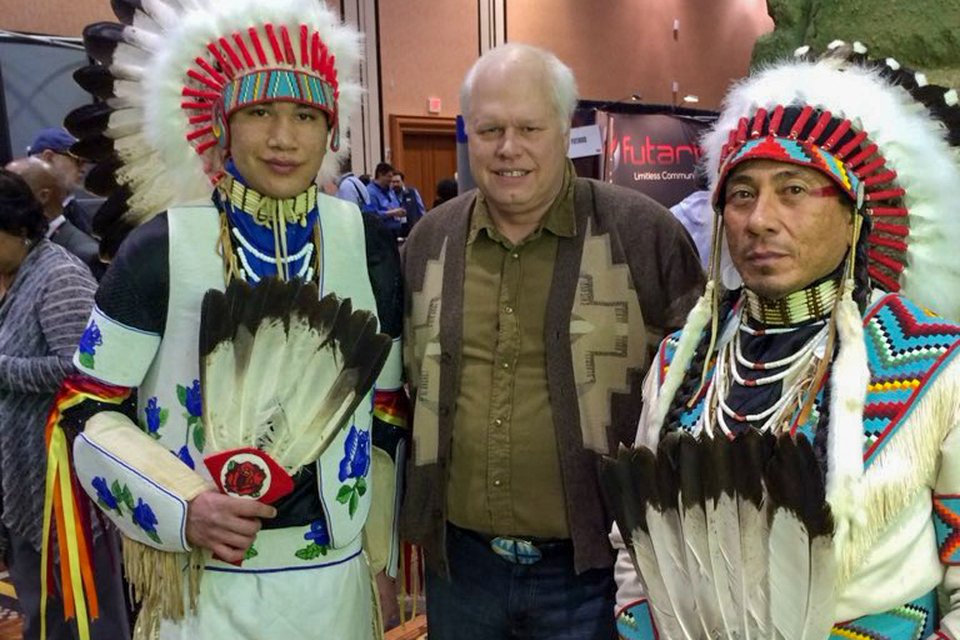St. Kateri Tekakwitha and Servant of God Nicholas Black Elk highlighted as models of faith; participants share own family stories
REDFORD TOWNSHIP — Members of the faithful gathered Nov. 22 to remember and celebrate their American Indian ancestors, heritage and Catholic faith.
The celebration at St. John XXIII Parish in Redford Township was sponsored by the Archdiocese of Detroit's Office of Cultural Ministries and led by Deacon Steve Morello, himself a member of the Sault Ste. Marie Tribe of Chippewa Indians, and the archdiocese's missionary to American Indians.
Deacon Morello leads the St. Kateri Tekakwitha-Nicholas Black Elk Circle, which hosted the celebration in collaboration with the archdiocese and the Adrian-based Dominican Center: Spirituality for Mission in honor of Native American History Month.
Deacon Morello likened November, when the American Indian community commemorates and remembers their ancestors, to the All Saints and All Souls feast days, when the Church remembers and prays for the faithful departed.
“In American Indian spirituality, this is a month where we American Indians remember our ancestors,” Deacon Morello said. “We remember that we are always connected, even though they’ve walked on and gone to the spirit world, we’re still connected to them because we are connected to all living things and even inanimate things. Everything that’s created by God, our Creator, is related to us because they were created by the same God who created us.”


Following a smudging ceremony, where incense is burned and passed through the assembly as a welcoming ritual, speakers gave presentations on St. Kateri Tekakwitha and Servant of God Nicholas Black Elk, examining how they incorporated their American Indian spirituality and identity with Christian discipleship.
Fr. Charles Morris, a priest of the Archdiocese of Detroit and a retired professor of religious studies at Madonna University, spoke about St. Kateri Tekakwitha, a native Mohawk who converted to the Catholic faith when she was 18, taking a vow of perpetual virginity and leaving her village after her relatives wanted her to marry.
“Her conversion and vow of perpetual virginity ran countercultural to her neighbors, so they stared rumors of sorcery and all kinds of things again her,” Fr. Morris said. “So to avoid persecution, like Moses and the Israelites of old, she crossed the St. Lawrence River and found safe harbor near Montreal.
“Like other great saints, such as St. Therese and St. Elizabeth, it’s not the number of years you’re living, but what you do with the years you’re living,” Fr. Morris added. “She made a difference in the 24 years that she lived, living a very devout, prayerful life, and being an evangelist to native peoples.”
Sr. Janice Brown, OP, an Adrian Dominican and director of the Dominican Center: Spirituality for Mission, spoke about Servant of God Nicholas Black Elk, a member of the Oglala Lakota people. Nicholas Black Elk, after receiving a vision from God of all people coming into the Church, converted to Catholicism in 1904, and in 1907, the Society of Jesus appointed him a catechist to teach the truths of the faith to American Indians.


“Like St. Paul, Nicholas Black Elk traveled widely, preaching, telling stories and writing pastoral letters with Bible verses on good Christian living for the Lakota people,” Sr. Brown said. “As a catechist, he is credited with leading more than 400 native people to baptism. His model lifestyle continues to inspire thousands of people making their spiritual journey.”
When Nicolas was nearing his death in 1950, he "humbly predicted" there would be a sign, Sr. Brown said.
“On the night of his wake service at St. Agnes Parish in Manderson, South Dakota, the Northern Lights danced vigorously overhead with extraordinary display and unprecedented brilliance and could be seen around the world," Sr. Brown shared. "His friend, John Lone Goose, reflected, 'God sent light to shine on that beautiful man.'”
After the presentations, attendees shared stories about their own ancestors, passing around photographs, letters and items from their families' histories.
The group then paused to give God thanks by praying facing the four directions — north, east, south and west — each direction carrying symbols of significance to the American Indian community about the bountiful gift of God’s creation.
God’s graces can be seen in all of creation, Deacon Morello said, be it in nature, or the lives of the people who have passed on the faith and cultural traditions.
“Nicholas Black Elk’s life and witness is a testament to God’s grace,” Deacon Morello said. “He was 10 years old at the Battle of Little Big Horn, one of the most ferocious Indian war battles in history, but he was there as a witness, not a warrior. His story would be as a catechist, evangelizing and bringing native people to the Lord.
“It’s a fascinating story. We all have similar stories, similar people in our lives who have gone before us," Deacon Morello added. "And in all of those stories, we see God’s presence. It’s a miracle.”
Copy Permalink
Native American ministry












